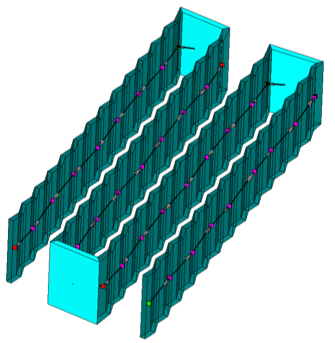The battery has emerged as the most prominent energy storage device to meet changing consumer needs in both the electric mobility and stationary energy storage industries. All major vehicle original equipment manufacturers (OEMs) have goals to electrify their fleets aggressively, adding electric vehicles (EVs) and hybrid-electric vehicles (HEVs) to their selections—some are even promising to go fully electric in just a few years. As a result, many engineers who have typically worked on conventional vehicles are now being asked to work on EVs and HEVs. As these engineers face the challenges of designing new technologies, modeling, and simulation tools are critical to creating robust thermal management strategies.
Thermal Management Strategies for EVs
Thermal management is critical for battery performance and service life. When deciding how to package and integrate a battery pack into a vehicle, you must make design choices with your thermal management strategy in mind. Batteries are like Goldilocks—they do not perform well when it is too hot or cold. They must maintain the just right temperature to achieve the performance, reliability, and safety desired by OEMs. Poor thermal management will affect the battery pack's charging and discharging power, service life, cell balancing, capacity, and fast charging capability. A proper cooling strategy will ensure an even temperature distribution and eliminate potential hazards from unregulated battery temperatures.
Balancing thermal management design trade-offs is impossible when OEMs desire lightweight, compact, reliable, serviceable, and low-cost solutions. This blog will look at current battery packaging and thermal management trends, including passive cooling, active air cooling, and liquid cooling thermal management strategies.
Passive Cooling
The passive cooling strategy is the most straightforward approach, taking advantage of conduction through mounts and brackets, as well as natural convection with the air in the pack, to transfer the heat generated inside the pack to the environment with no additional hardware for increasing heat transfer. Passive cooling is low-cost and "energy-efficient," as it requires no energy from the car. However, even though it is the most prevalent cooling method seen today, it cannot keep a battery pack within optimal cooling temperatures for high-performance applications and long-distance driving with multiple fast charges. This method is falling out of favor as companies seek thermal management strategies that keep warranty claims to a minimum and extend usability.
Active Air-Cooling
The active air-cooling strategy uses a fan with forced air passed over the batteries to remove heat. This strategy extends the lifetime of the battery pack compared to passive cooling as it keeps the batteries at a more consistent operating temperature. It is cheaper and lighter than liquid cooling and is more manageable to design because it does not have to interface with the other cooling networks in the vehicle. However, developing battery packaging and mounting for airflow can be challenging. Bracing and mounts can get in the way of airflow, and it can be challenging to distribute the airflow to maintain a uniform temperature. Using modeling techniques such as Computational Fluid Dynamics (CFD) or fluid nodal networks helps engineers solve these problems, but they can be tricky to overcome given the size and weight restrictions associated with designing a vehicle. Even though active air cooling is better than passive cooling at maintaining optimal operating temperatures, liquid cooling is the most effective way to keep a uniform temperature within a pack and meet warranty requirements. 
Liquid Cooling
Liquid cooling is the most effective way to remove heat from the battery pack. It is also better than active air cooling at keeping the battery pack within optimal operating temperatures. Designing a system that uniformly cools all the batteries leads to better battery performance and lifetime. Liquid cooling also allows the battery pack to be operated with higher peak power loads because it dissipates more heat than other cooling methods.
There are three main approaches to liquid cooling: serpentine ribbon-shaped cooling tubes, cooling plates with cooling channels inside them, and direct/immersive cooling. The cooling tube approach is the most effective at maintaining uniform cell temperatures but is more challenging to manufacture and can result in higher pressure drops. The cooling plate approach is reasonably simple to implement but can lead to large temperature gradients across individual batteries. The direct cooling approach may present the most effective means of heat removal but is relatively new and requires expensive dielectric coolants instead of conventional cooling fluids.

Designing a system with liquid cooling can be more challenging because it has to be integrated with other electrical and fluid systems in the vehicle. The potential for a fluid leak must also be considered because it can cause an electrical short. Liquid cooling systems are generally heavier, more expensive, and more complicated to repair. However, the trade-offs can be worth it because liquid cooling systems provide an extended lifetime and higher performance than air-cooled and passively cooled packs of the same size.
Key Indicators for Thermal Management Success
Despite each cooling strategy's many benefits and drawbacks, one is generally best for a specific vehicle design and customer use case. Battery lifetime and performance are critical indicators of success for car owners, so regardless of the particular vehicle model and customer usage pattern, the right thermal management strategy will always be essential for success.
Using Simulation to Discover the Best Strategy
Finding the best thermal management strategy for a vehicle design can be taxing. As with conventional internal combustion engine vehicles, thermal analysis software helps design EVs and HEVs by allowing an engineer to look at design performance for many different environments and operational scenarios with little effort to run additional conditions. The alternative is the "test-and-fix method," which is expensive and time-consuming. A prototype has to be made before a new design can be tested, and then a new prototype must be built for each successive design modification. The additional time it takes to complete the “test-and-fix” method can limit the ability of engineers to reach an optimal design. Simulation helps engineers stay ahead of the curve by analyzing designs numerically and confirming them with physical testing after achieving confidence in the design.
Using Simulation for Full Vehicle Analysis
Using simulation allows a designer to see how the battery pack, packaging, and cooling method integrate with the entire vehicle. Fast and accurate simulation software lets a designer evaluate the full vehicle in 3D. This means teams can understand how their changes affect other systems and work together to balance design priorities.
Using Simulation for Cabin and Drive Cycle Analysis
Adopting simulation can further improvement for the entire vehicle by using advanced modeling techniques. These techniques include analyzing cabin comfort and how it affects the range of the vehicle; examining different drive cycles in various situations like city driving, race track driving, and key-off scenarios; or researching the lifetime predictions of a battery utilizing different duty cycles. 
Using simulation opens doors for greater innovation and collaboration. The automotive industry continues to trend toward design initiatives that cost less, resulting in better designs and more visibility for all teams and team members, making a vehicle design successful. Simulation is the best way to remain competitive in an environment where efficiency, cost, and superior design win the day.
No matter where you are in your simulation journey, we are here to help you take the next step toward more advanced methods. If you want to take the next step toward thermal management success with TAITherm, contact our technical sales team to discuss how the tool can advance your project.

Visit our website at suppport.thermoanalytics.com for
- FAQs
- Webinars
- Tutorials
Get help from our technical support team:

